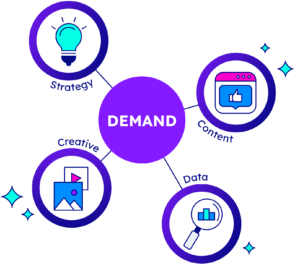It’s not just you. Thus far, 2025 isn’t cutting B2B marketers any slack. There are economic headwinds to contend with, longer sales cycles to navigate, and tighter budgets to manage. While complexity is nothing new, the constant uncertainty — and the pressure to deliver more with less — makes today’s environment particularly tricky to navigate.
To understand how marketers are faring, we surveyed more than 500 B2B revenue leaders across the U.S., UK/Europe, and APAC. We also spoke with teams at Adobe, Revere Agency, Dataminr, and others to bring the numbers to life.
What we found is a growing divide. While many marketing teams are stuck fighting uphill battles, a smaller group of high performers is pulling ahead. They’re better aligned with sales, laser-focused on outcomes, and stretching their resources without sacrificing results.
Here’s what our 2025 State of B2B Pipeline Growth report shows is driving that divide — and what today’s top-performing marketing teams are doing to stay ahead.
Economic Uncertainty Remains the #1 Challenge for Marketers Globally
Ask any B2B marketer what’s weighing most on their plans this year, and you’ll hear a familiar answer: economic uncertainty. It’s the top challenge for nearly half (45%) of the leaders we surveyed. Macro challenges are having knock-on effects within organizations: flat budgets and headcount, along with slipping engagement.
This tension is present throughout the data:
- 63% of teams are working with the same or fewer marketing dollars than last year.
- Just 37% saw a budget increase, down from 52% in July 2024.
- Only 40% of teams are growing headcount; the rest are holding steady or cutting.
But not all teams are in survival mode. High performers are bucking the trend — not because they have bigger budgets or teams, but because they’re putting their resources to better use.
Top teams are four times more likely to hit or exceed their goals, and when they do, the rewards follow: 65% earned a budget increase, while half of low performers saw cuts. It’s a flywheel: deliver results, earn resources, reinvest, repeat.
Data Effectiveness Is the Single Biggest Predictor of Performance
The largest gap in our study — 65 points — came down to how well teams collect, analyze, and act on data.
Among high performers, data is a strength:
- 30% rate their data capabilities as “excellent”
- Another 49% say “very good”
- Just 8% say they struggle
For low performers, the opposite is true. They’re less likely to be confident in their data and more likely to struggle with interpreting it in a way that drives decisions.
It’s no surprise, then, that data tops the list of investment priorities heading into 2025:
- 60% plan to go deeper into performance analysis
- 47% are focused on improving data collection
- 45% are prioritizing better interpretation and reporting
ROI Now Defines the B2B Marketing Mandate
That focus on better data isn’t happening in a vacuum. It’s a direct response to a broader shift — marketing teams are being asked to prove value in more concrete terms. Vanity metrics like impressions and pageviews are being deprioritized in favor of KPIs that can be directly traced to revenue.
Whether it’s the CMO, the CFO, or the board, every stakeholder is asking the same question: What are we getting for our marketing spend?
That shift shows up in the metrics marketers are tracking. Website traffic (43%) still matters, especially for top-of-funnel activity — but revenue (42%) has surged to near the top of the list. And SQLs (39%) are close behind, reflecting the growing pressure to prove marketing’s impact further down the funnel.
High performers are leaning into this shift. Half of them say revenue is now their primary KPI. They’re also tracking more metrics overall — 3.5 on average vs. 2.4 for low performers — giving them a fuller picture of what’s working and where to adjust.
In a year when every dollar is under scrutiny, the teams that can connect their work to real business outcomes are the ones most likely to keep performing well despite the pressure.
Sales Cycles Are Getting Longer and Messier
Tighter budgets aren’t the only thing slowing teams down. Deals are taking longer to close — and for many, it’s not just a few extra days. Nearly three-quarters of marketers said their sales cycles have increased by two months or more.
So, what’s behind the slowdown?
- Buying groups are bigger, sometimes 20 people deep.
- Finance is showing up late in the process with new questions.
- Short-term budget scrutiny is pushing decisions further down the road.
This dynamic is forcing marketers to rethink how and when they engage. The buyer journey no longer moves in a straight line. Prospects bounce around, deals stall and restart, and every detour threatens to stall momentum.
The impact isn’t felt evenly. It’s most pronounced in the UK and Europe, where 78% of marketers reported longer sales cycles, compared to 73% in APAC and 70% in the U.S.
Still, high performers are adapting. They’re not just pushing more leads into the funnel — they’re rethinking how to support sales through a more unpredictable, nonlinear journey. That means engaging earlier, staying present longer, and showing value to a broader set of decision-makers across every stage of the deal.
Email Marketing Dominates Lead Generation, but It’s What Comes Next That Matters
Email continues to be the go-to lead gen channel for B2B marketers, and for good reason. It’s cost-effective, easy to scale, and immune to the ups and downs of ad platforms — which helps explain why 66% of marketers ranked it as one of their most effective channels. Paid social (58%) and paid search (50%) follow close behind, but email continues to punch above its weight.
That said, the differentiator is how teams are using these channels. High performers still lean on email (72% cite it as their go-to), but they’re building diverse, multi-touch strategies around it:
- 34% are tapping into partner programs
- 36% are layering in offline tactics like direct mail
The performance gap really shows up in lead nurturing. Only 41% of marketers overall say their nurturing programs are “very good” or “excellent.” But among high performers? That number jumps to 69%. That’s a 28-point difference — one of the clearest signals in the report that post-lead strategy separates good teams from great ones.
Sales-Marketing Alignment Is Still a Work in Progress — Except Among Top Performers
B2B marketing teams have a lot of work to do around alignment. Just 11% of respondents said their teams are fully aligned with sales. More than a third describe the relationship as rocky at best — marked by silos, mismatched goals, or a lack of collaboration.
It’s a very different story among higher performers:
- 75% say they’re mostly or fully aligned.
- They’re 5x more likely to achieve full alignment than low performers.
- They’re more likely to share KPIs and collaborate on lead qualification.
It’s also clear where misalignment does the most damage: late in the funnel. Marketers told us the biggest drop-off points are in qualifying leads, closing deals, and retaining customers — all shared spaces between marketing and sales. The message is hard to miss: the handoff model is breaking down, and high performers are moving toward a model of shared ownership across the entire revenue journey.
Where B2B Marketers Go From Here
If there’s one thing this year’s report makes clear, it’s that the gap between top B2B marketers and everyone else is widening. Conditions are tough, but rather than waiting for them to improve, these elite teams are finding ways to adapt.
If you’re looking to do the same, here’s where to focus:
- Strengthen your data capabilities.
- Build tighter alignment with sales.
- Invest in lead nurturing — not just lead gen.
- Connect your efforts to revenue.
- Support longer sales cycles with smarter engagement.
None of this is easy. But the playbook is there — and the teams that follow it are showing what’s possible, even in a tough market.
Want a deeper look at the data? Download the full report and infographic for all the insights, regional breakdowns, and takeaways to guide your strategy in 2025.





